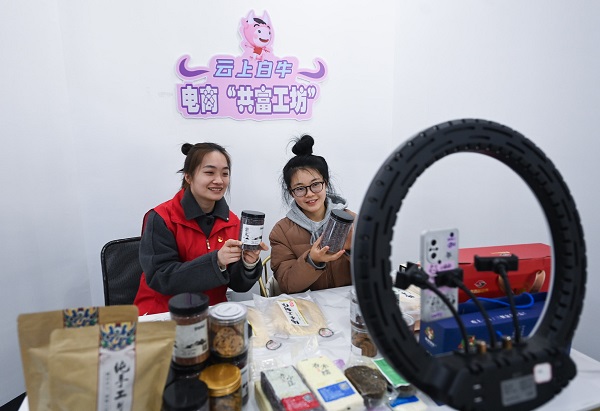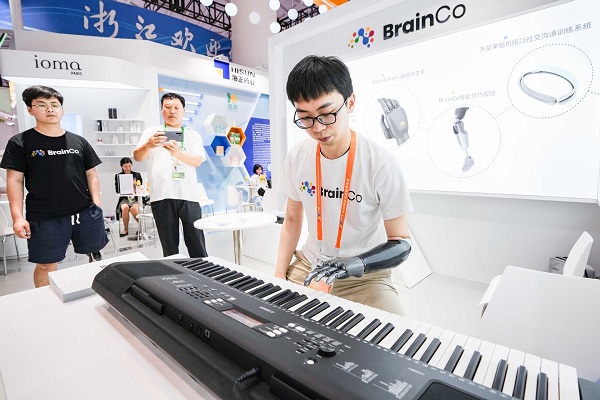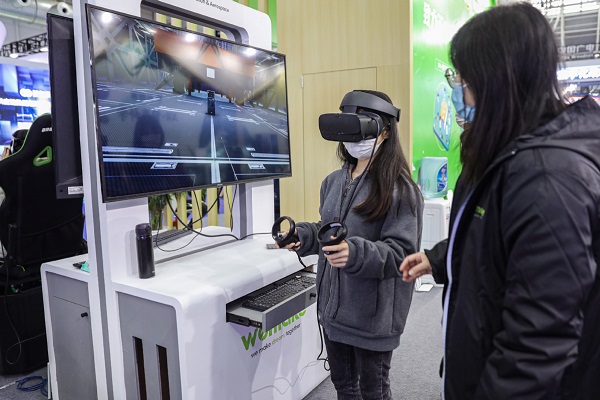new growth impetus spurs local development

a grassroots member of the communist party of china (left) and an e-commerce anchor promote agricultural products on a livestream named "common prosperity workshop" in lin'an district, hangzhou, zhejiang province, on march 28. [photo by xu yu/china news service]
industries, investment and consumption gain as online economy evolves fast
china's digital economy is entering a new stage of development wherein emphasis will be more on business-oriented applications like industrial internet, which can facilitate integration of the digital and real economies, government officials and experts said.
sensing the trend, local governments are accelerating the digital transformation and upgrade of industries, which is expected to fuel china's economic growth and innovation-driven high-quality development in spite of numerous challenges and external uncertainties.
thirty-one provincial regions in the chinese mainland have all highlighted the goal of developing the digital economy in their economic development plans.
shanghai, for instance, aims to improve the output of its digital economy-related core industries to 18 percent of the city's gdp in the coming four years from 15 percent last year when the city's gdp was 4.47 trillion yuan ($648.93 billion).
the output of the digital economy-related core industries of zhejiang province is expected to reach 1.6 trillion yuan by 2027, according to its plan.
wang zhiqin, vice-president of the china academy of information and communications technology, said the ultimate reason behind boosting the development of the digital economy is that it will bring new growth impetus to local economic development, especially in industries, investment and consumption.
according to her, previously, china's digital economy was chiefly driven by consumer-oriented internet applications like e-commerce, but now business-oriented applications like industrial internet are playing a significantly bigger role. this shows that improvements have been made to the digital economy structure.

an exhibitor demonstrates an intelligent bionic hand during the third china international consumer products expo held in haikou, hainan province, on april 11. [photo by wang chenglong/for china daily]
well aware of the change, local governments have mapped out specific measures to develop the digital economy, with each province's or region's specific goals slightly different from those of others, based on the development level of its own digital economy. for instance, industrial digitalization will be prioritized in manufacturing clusters while computing centers will be prioritized in energy-rich regions.
for instance, central china's henan province, home to the world's largest iphone factory, will invest 50 billion yuan on digital infrastructure expansion, according to a work plan recently released by the henan development and reform commission.
the province will also promote the digital transformation of its manufacturing sector. this would involve building 150 smart factories and 10 provincial-designated industrial internet platforms.
local governments' efforts to accelerate the development of the digital economy are in line with china's plan to boost the output of core industries of the country's digital economy to 10 percent of the country's gdp by 2025, up from 7.8 percent in 2020, as noted in china's 14th five-year plan (2021-25). china's gdp in 2022 was 121 trillion yuan.
china will take solid steps to build digital infrastructure and data resource systems, and to promote the in-depth integration of digital technologies with the economy, politics, culture, society and ecology, according to a plan jointly released by the communist party of china central committee and the state council, china's cabinet, on feb 27.
the plan stated that important progress will be made in the construction of a digital china by 2025, with effective interconnectivity in digital infrastructure, a significantly improved digital economy, and major breakthroughs achieved in digital technology innovation.
in march, china also announced a plan to establish a national data bureau, which is expected to give full play to the value of data, quicken the building of basic systems for data, and inject strong impetus into the digital economy.

a visitor (left) experiences an extended reality (xr) head-mounted display during the 2023 qingdao digital culture application development expo held in qingdao, shandong province, on april 7. [photo/china daily]
wei jianguo, former vice-minister of commerce and vice-chairman of the china center for international economic exchanges, said, "china's efforts in developing the digital economy will enable companies to not only lead development in various business sectors in the domestic market, but also compete further on the global stage in the future."
a white paper released by the china academy of information and communications technology, a government think tank, showed that the market scale of china's digital economy reached 45.5 trillion yuan in 2021, the world's second-largest.
the number is expected to surpass 60 trillion yuan by 2025, the academy forecast.
zhang yunming, vice-minister of industry and information technology, recently called on telecommunications companies such as china mobile, china unicom and china telecom to beef up the construction and application of "new infrastructure", deepen efforts to promote an innovation-driven development strategy, and advance the integration of the digital and real economies.
by the end of 2022, more than 2.3 million 5g base stations had been built in china, and the country boasts a capability to connect over 500 million households with a gigabit optical network, data from the ministry of industry and information technology showed.
moreover, the digital connections for the mobile internet of things or iot in china reached 1.84 billion in 2022, making china the first major economy in the world to have more mobile iot connections than the number of its mobile users, according to the ministry. iot refers to a network of devices, vehicles and other objects that contain software or sensors allowing them to connect and exchange data.
china's mobile iot connections account for 70 percent of the world's total and now cover all the 45 major categories of the national economy, said zhao zhiguo, spokesman for the ministry.
such telecom infrastructure will lay a sound foundation for the high-quality development of china's digital economy, experts said.
a typical example is a wider application of 5g plus industrial internet in traditional sectors, which has advanced the long-predicted convergence of digital technologies and industrial worlds. such change is profound at a steel company in xiangtan, hunan province.
the labor-intensive iron and steel industry, as a symbol of the second industrial revolution, was often associated with images of workers toiling away in mills, sweat pouring down their faces.
but now, inside the control room of hunan valin xiangtan iron and steel co, a completely different picture is taking shape. four technicians operate joysticks to remotely control bridge cranes moving back and forth in a nearby high-temperature plant. via a big screen that features a real-time video of plant operations, the employees monitor the processes — and all the equipment moves in an orderly fashion.
"previously, the control center had to be placed within a steel plant to allow it to control the process without a time delay. we had to work in an environment with searing temperatures, loud noise and dust. but all of this has changed due to the 5g network," said liu jiwen, who is in charge of the company's 5-meter plate production facility.
according to liu, 5g's low latency and large bandwidth mean the control center can now be located in a cozy room outside the mill, and one employee can remotely operate multiple bridge cranes simultaneously, significantly boosting efficiency.
the plant is one of the more than 4,000 5g industrial internet projects currently under construction in china, as the nation beefs up its industrial upgrade drive in an attempt to facilitate the marriage between digital technologies and traditional sectors.
yang chaobin, senior vice-president of huawei, said the vitality of the digital economy can be evaluated by three factors: connection density, computing diversity and carbon reduction intensity. these factors give operators the levers they need to shape the future of the digital economy.
by increasing connection density, operators can grow their 5g user base and expand their business scope. by diversifying computing resources, operators can create synergies between connectivity and it to boost enterprise digitalization for new growth. for carbon reduction, new green information and communication technology solutions huawei provides will increase network capacity and cut the energy consumption per bit for greener development, yang said.
-
'nice' to meet you, hangzhou
may 6, 2024

